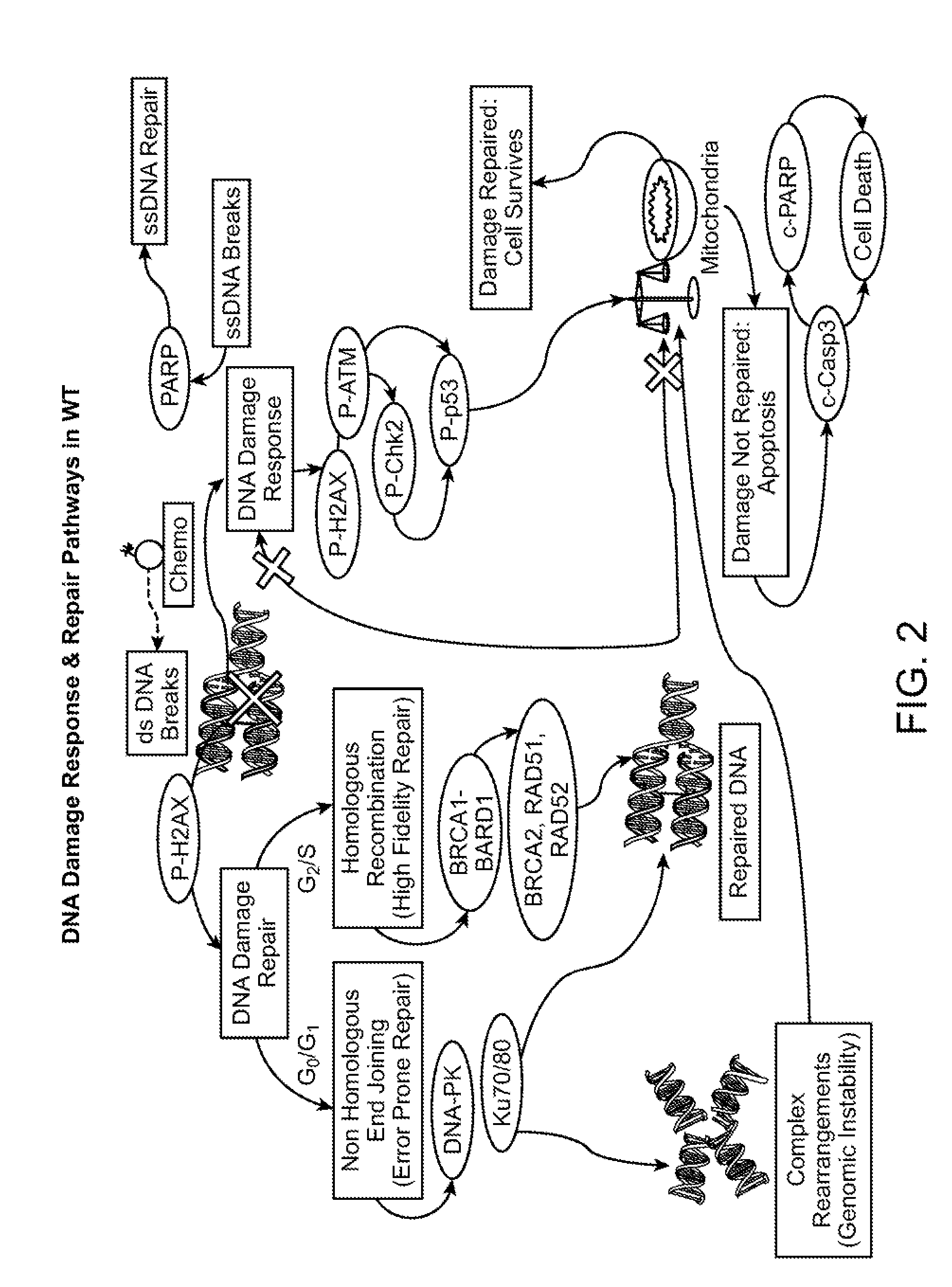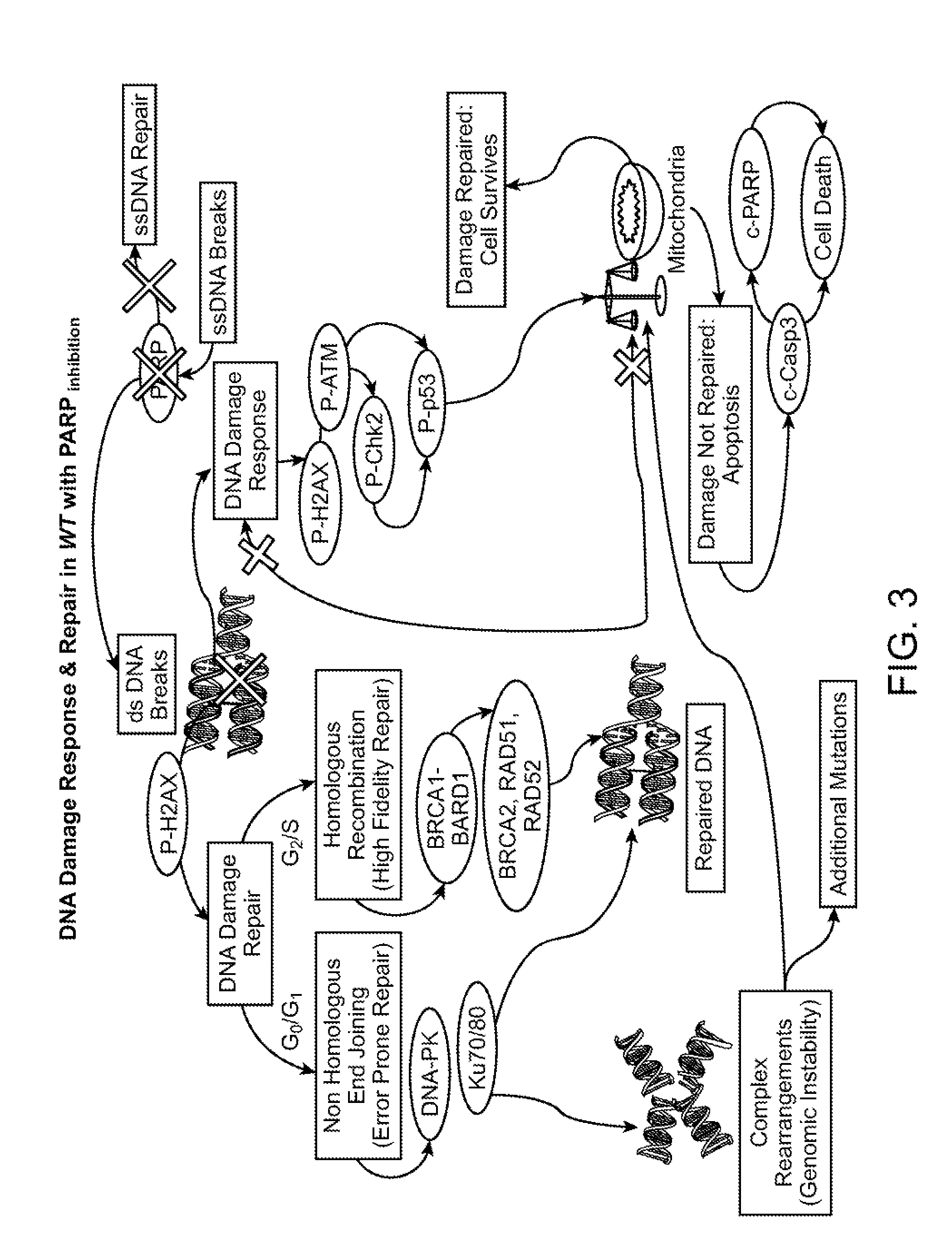Pathways characterization of cells
a cell and pathology technology, applied in the field of pathology characterization of cells, can solve the problems of increasing the rate of spontaneous mutations and underestimating the presence of gene inactivation
- Summary
- Abstract
- Description
- Claims
- Application Information
AI Technical Summary
Benefits of technology
Problems solved by technology
Method used
Image
Examples
example 1
Analysis of BRCA1 and BRCA2 Protein Network in Single Cells
[0302]Patient samples: Sets of fresh or cryopreserved samples from patients can be analyzed. The sets can consist of peripheral blood mononuclear cell (PBMC) samples or bone marrow mononuclear cell (BMMC) samples derived from blood. All patients will be asked for consent for the collection and use of their samples for institutional review board (IRB)-approved research purposes. All clinical data will be de-identified in compliance with Health Insurance Portability and Accountability Act (HIPAA) regulations. Samples can include those collected from breast cancer patients with a mutation in BRCA1 or BRCA2, patients with a triple-negative carcinoma phenotype (negative for estrogen receptor, progesterone receptor, and human epidermal growth factor receptor 2) that are BRCA1 and BRCA2 wild type, and patients without breast cancer that lack BRCA1 and BRCA2 mutations. A study could be set up to analyze samples from patients in for ...
example 2
Analysis of p53 Levels
[0313]Background
[0314]The p53 tumor suppressor is a transcription factor that is a tightly regulated protein that is involved in cell cycle arrest and induction of apoptosis in genetically damaged cells. Mutations or deletions of the p53 gene may facilitate the transmission of genetic damage and the emergence of neoplastic clones with a survival advantage. Wild type p53 has a short half-life (due to continuous ubiquitylation and subsequent degradation by the 26S proteosome) and cannot be detected in the cell nucleus of most human cells. In contrast, mutated p53 has a prolonged half-life and becomes detectable by immunological techniques using p53 antibodies.
[0315]Summary of p53 Functional Regulation
[0316]When a cell is subjected to stress, p53 is stabilized in the nucleus, where it initiates cellular responses through a transcriptional program by which distinct target genes whose function is primarily to prevent proliferation of damaged cells.
[0317]The function...
example 3
Genomic Instability Analysis
[0338]Genomic instability is a hallmark of cancer. Germline mutations in DNA repair genes and / or genes that primarily function to maintain genomic stability may drive cancer development by increasing the spontaneous mutation rate. Examples of cancers associated with germline mutations associated include Hereditary non-polyposis colorectal carcinoma, Bloom's syndrome, Ataxia-telangiectasia (ATM mutation), BRCA-associated breast and ovarian cancers, Fanconi anaemia, Retinoblastoma. Somatic mutations in DNA repair genes and / or genes that function to maintain genomic stability and arise in the course of cancer genesis and progression, e.g., p53. Genomic Instability may be the basis for increased sensitivity / resistance to DNA damaging agents and can be exploited by synthetic lethality.
[0339]Synthetic Lethality exploits the dependence of the cancer cell upon a particular repair pathway, due to inactivating mutation in alternative(s). For example, cells that hav...
PUM
| Property | Measurement | Unit |
|---|---|---|
| pore sizes | aaaaa | aaaaa |
| concentration | aaaaa | aaaaa |
| concentration | aaaaa | aaaaa |
Abstract
Description
Claims
Application Information
 Login to View More
Login to View More - R&D
- Intellectual Property
- Life Sciences
- Materials
- Tech Scout
- Unparalleled Data Quality
- Higher Quality Content
- 60% Fewer Hallucinations
Browse by: Latest US Patents, China's latest patents, Technical Efficacy Thesaurus, Application Domain, Technology Topic, Popular Technical Reports.
© 2025 PatSnap. All rights reserved.Legal|Privacy policy|Modern Slavery Act Transparency Statement|Sitemap|About US| Contact US: help@patsnap.com



